Gratitude and Beginnings
I am extremely grateful to the people who are supporting me on my journey to a career in medicine. Currently, I am gaining invaluable experience in a pharmacy owned by Rocky Kaku. This pharmacy is also one of the three main chambers where my grandfather, a General Practitioner (GP), still practices in India.
Learning the Beginnings
During my time here, I’ve learned a lot about the general workings of a pharmacy in India. One of the key aspects is that every sale must be logged, including the customer’s name, the product they are purchasing, and their phone number. Some pharmacies prefer to do this on paper, while others use specialized software that also helps manage stock and monitor medications that are running low.
The Importance of Marketing
I’ve realized that marketing is crucial for the success of medicine brands in the competitive market here. The sheer volume of different brands selling slightly varied versions of cough syrup is astonishing. To effectively market a specific medication in India, it must be promoted to both the GP and the pharmacist. Free samples are often given to both, ensuring that the GP prescribes the new medicine and the pharmacy stocks it.
Organising Medicines
In a pharmacy, medicines are usually organized in two distinct ways. The first method is by type and function, where all cough syrups, multivitamins, or skincare lotions are placed together. This is what you might call categorical organization. The second method, which I half expected to see, is alphabetical organization, where medicines without an outer packet are placed in drawers labeled with letters.
The Payment System
The payment system in pharmacies is closely linked to the chamber where the doctor sits. Sometimes, the doctor’s chamber is not directly inside the pharmacy shop but might be across the road. When a patient visits a chamber, they first go to the linked pharmacy to request a slip containing their name and queue number. They then pay 200 rupees in fees to the pharmacy, plus an additional 50 rupees as the pharmacy’s own charge.
Interestingly, the doctor can waive their own fee (200 rupees) for well-known patients, family members, or those experiencing financial hardships. However, the 50 rupee fee charged by the pharmacy cannot be waived by the doctor; it is up to the pharmacist to decide whether to charge it or not. This 50 rupee fee acts as a hook to ensure that the patient does not leave after just getting a prescription. It essentially serves as a commission for allowing the doctor to practice at a chamber funded by the pharmacist, while also encouraging the patient to buy medicines from the same pharmacy.
Conclusion
My experience in this pharmacy has been enlightening, providing me with a deeper understanding of the intricacies involved in running a pharmacy in India. From logging sales to marketing strategies and payment systems, each aspect plays a vital role in the smooth functioning of a pharmacy. This journey has not only enriched my knowledge but also strengthened my resolve to pursue a career in medicine.

No responses yet